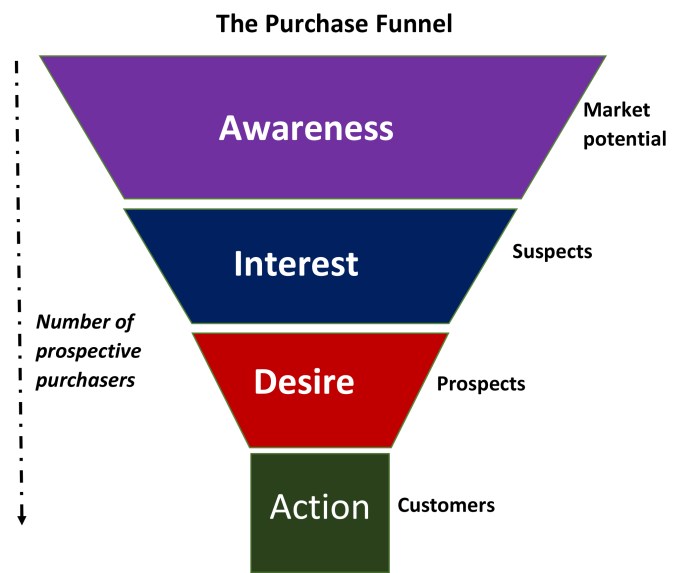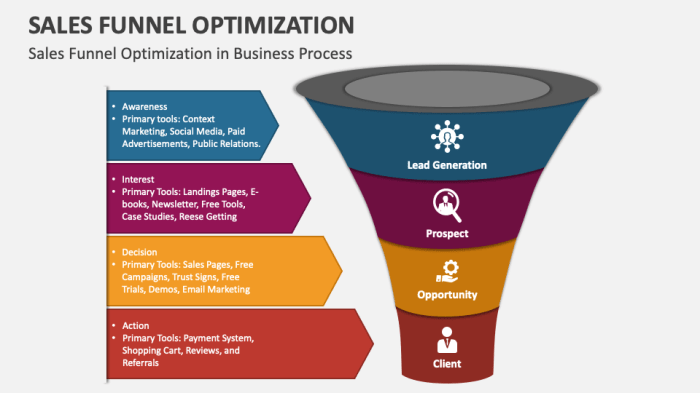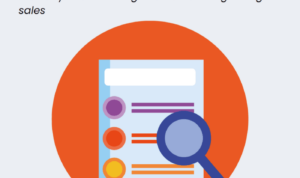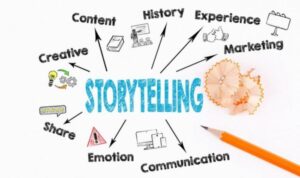Sales Funnel Optimization sets the stage for this enthralling narrative, offering readers a glimpse into a story that is rich in detail and brimming with originality from the outset. Dive into the world of maximizing sales funnels to drive success and growth in the digital realm.
Introduction to Sales Funnel Optimization

A sales funnel is a marketing concept that represents the journey a potential customer goes through before making a purchase. It typically includes stages such as awareness, interest, decision, and action. Sales funnels are crucial in marketing as they help businesses understand the customer’s buying journey and optimize their strategies to convert leads into customers.
Sales funnel optimization refers to the process of improving each stage of the sales funnel to maximize conversions and revenue. By analyzing data, testing different approaches, and refining the customer experience, businesses can enhance their sales funnels and drive more sales.
Benefits of Sales Funnel Optimization
- Increased Conversion Rates: Optimizing the sales funnel can lead to higher conversion rates as potential customers move smoothly through the buying process.
- Improved Customer Retention: By providing a seamless experience, businesses can retain customers and encourage repeat purchases.
- Enhanced ROI: Effective sales funnel optimization can result in a higher return on investment by targeting the right audience and improving overall efficiency.
Examples of Successful Sales Funnel Optimization
Many companies have successfully optimized their sales funnels to drive growth and increase revenue. One notable example is Amazon, which uses personalized recommendations and a user-friendly checkout process to optimize their sales funnel and boost sales. Another example is Netflix, which leverages data analytics to deliver targeted content recommendations and improve customer retention.
Key Stages of a Sales Funnel

In a typical sales funnel, there are four key stages that a potential customer goes through before making a purchase: awareness, interest, decision, and action. Each stage plays a crucial role in converting leads into customers by guiding them through the buying process.
Awareness Stage
The awareness stage is where the customer becomes aware of your product or service. Strategies to move leads smoothly through this stage include creating engaging content, utilizing social media platforms, and running targeted advertising campaigns to increase brand visibility.
Interest Stage
Once a lead is aware of your product, the interest stage focuses on capturing their attention and generating curiosity. Strategies for this stage include offering free trials, hosting webinars or demos, and sending personalized emails to provide more information and establish a connection with the lead.
Decision Stage
In the decision stage, the lead evaluates their options and decides whether to make a purchase. Strategies to facilitate this stage include offering discounts or promotions, providing customer testimonials and reviews, and creating urgency through limited-time offers to help the lead make a decision.
Action Stage
The final stage of the sales funnel is the action stage, where the lead converts into a customer by making a purchase. Strategies to encourage action include simplifying the checkout process, offering multiple payment options, and providing exceptional customer support to ensure a smooth transition from lead to customer.
Analyzing Customer Behavior
Understanding customer behavior is crucial in optimizing sales funnels as it provides valuable insights into how potential customers interact with the sales process. By tracking and analyzing customer actions at each stage of the funnel, businesses can make informed decisions to improve conversion rates and overall performance.
Tools and Techniques for Tracking and Analyzing Customer Interactions
- Google Analytics: This tool provides in-depth data on website traffic, user behavior, and conversion rates, allowing businesses to track customer interactions and identify areas for improvement.
- CRM Systems: Customer Relationship Management systems help businesses track customer interactions, preferences, and purchasing history, providing valuable insights for optimizing the sales funnel.
- Heatmaps: Heatmap tools visualize where customers click, scroll, and spend time on a website, helping businesses understand user behavior and make data-driven decisions.
Leveraging Customer Behavior Data to Improve Conversion Rates
- Personalization: By analyzing customer behavior data, businesses can personalize marketing messages, offers, and recommendations to better align with customer preferences and increase conversion rates.
- A/B Testing: Testing different variations of a webpage based on customer behavior data can help businesses identify the most effective strategies for improving conversion rates and optimizing the sales funnel.
- Segmentation: By segmenting customers based on behavior patterns, businesses can tailor their marketing efforts to specific customer groups, increasing the chances of conversion and maximizing ROI.
Creating Compelling Content: Sales Funnel Optimization
In the world of sales funnel optimization, content plays a crucial role in guiding potential customers through each stage of the journey. Compelling content can capture the attention of prospects, build trust, and ultimately drive conversions. Let’s dive into some tips for creating engaging and relevant content for each stage of the funnel, along with examples of successful content types.
Tips for Creating Engaging Content
Creating compelling content starts with understanding your target audience and their needs. Tailor your content to address specific pain points and provide valuable solutions. Make sure your content is visually appealing, easy to digest, and optimized for various devices. Personalize your messaging to resonate with your audience on a deeper level.
- Use storytelling to create emotional connections with your audience.
- Include eye-catching visuals such as videos, infographics, and images to enhance engagement.
- Write clear and concise copy that highlights the benefits of your products or services.
- Incorporate customer testimonials and success stories to build credibility and trust.
Relevant Content for Each Stage of the Funnel
Tailoring your content to match the awareness, consideration, and decision stages of the sales funnel is essential for guiding prospects towards conversion. Here are some examples of content types that have proven successful in driving conversions at each stage:
- Awareness Stage: Blog posts, social media content, educational videos
- Consideration Stage: Case studies, whitepapers, webinars
- Decision Stage: Product demos, free trials, customer reviews
Implementing A/B Testing
A/B testing, also known as split testing, is a method used to compare two versions of a webpage or marketing element to determine which one performs better. This process involves dividing your audience into two groups and showing each group a different version, then analyzing the results to see which version drives more conversions. A/B testing is crucial in optimizing a sales funnel as it helps businesses understand what resonates with their target audience and what improvements can be made to increase conversion rates.
Identifying High-Performing Elements
- By conducting A/B tests, businesses can identify high-performing elements in the sales funnel, such as headlines, call-to-action buttons, images, or content layout.
- Through A/B testing, companies can determine which version of a webpage or email campaign leads to higher engagement and ultimately more conversions.
- By analyzing the data from A/B tests, businesses can make data-driven decisions to refine their sales funnel and improve overall performance.
Best Practices for A/B Testing
- Clearly define the goal of the A/B test to ensure accurate data interpretation.
- Test one element at a time to isolate variables and accurately measure the impact of changes.
- Ensure your sample size is statistically significant to draw reliable conclusions from the test results.
- Run tests for a long enough duration to capture sufficient data and avoid drawing premature conclusions.
- Use A/B testing tools to automate the process and track results effectively.
Leveraging Automation and Technology
Automation and technology play a crucial role in streamlining the sales funnel optimization process. By leveraging automation tools and technology, businesses can improve efficiency, reduce manual tasks, and enhance the overall customer experience.
Automating Tasks
One of the key benefits of automation in the sales funnel is the ability to automate repetitive tasks such as lead nurturing, email marketing, and follow-ups. By using automated workflows, businesses can ensure timely and personalized communication with leads, ultimately increasing conversion rates.
Tools and Software, Sales Funnel Optimization
There are several tools and software available that can aid in automating tasks and improving efficiency in the sales funnel optimization process. Examples include Customer Relationship Management (CRM) software like Salesforce, marketing automation platforms like HubSpot, and email marketing tools like Mailchimp.
Seamless Integration
To seamlessly integrate automation into the sales funnel, businesses should first identify areas where automation can be most beneficial. This could include lead scoring, segmentation, and personalized content delivery. By setting up automated workflows and triggers, businesses can ensure a smooth transition between each stage of the sales funnel, leading to better results and higher conversion rates.
Measuring Success and KPIs
In order to optimize a sales funnel effectively, it is crucial to measure success and track key performance indicators (KPIs) that indicate the performance of the funnel. By setting measurable goals and continuously monitoring progress, businesses can make data-driven decisions to enhance conversions.
Key Performance Indicators for Sales Funnel Optimization
- Conversion Rate: This KPI measures the percentage of visitors who take the desired action, such as making a purchase or signing up for a newsletter. A higher conversion rate indicates a more effective funnel.
- Customer Acquisition Cost (CAC): CAC helps in understanding how much it costs to acquire a new customer. By optimizing the sales funnel, businesses can reduce CAC and improve profitability.
- Customer Lifetime Value (CLV): CLV helps in determining the total revenue a customer is expected to generate over their lifetime. By optimizing the funnel to increase CLV, businesses can focus on retaining valuable customers.
Setting Measurable Goals and Tracking Progress
Setting specific, measurable, achievable, relevant, and time-bound (SMART) goals is essential for tracking progress in optimizing a sales funnel. By defining clear objectives and regularly monitoring performance against these goals, businesses can identify areas for improvement and take necessary actions.
Continuous Monitoring and Adjustment based on KPI Data
- Regularly review KPI data: Analyze KPIs on a consistent basis to identify trends, patterns, and areas of improvement within the sales funnel.
- A/B testing: Implement A/B testing to compare different versions of the sales funnel and determine which performs better based on KPIs.
- Implement automation: Use technology and automation tools to streamline the sales funnel process and improve efficiency based on KPI insights.


